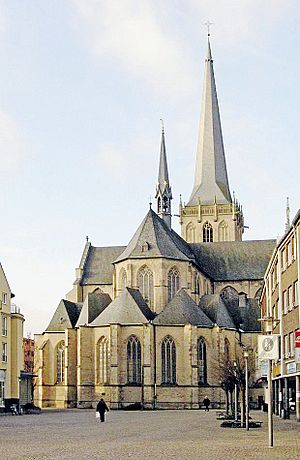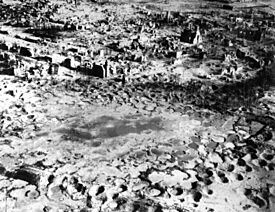Wesel facts for kids
Quick facts for kids
Wesel
|
|||
|---|---|---|---|

Willibrordi-Dom in Wesel. The cathedral, dedicated to St Willibrord, has been restored after wartime bombing.
|
|||
|
|||
| Country | Germany | ||
| State | North Rhine-Westphalia | ||
| Admin. region | Düsseldorf | ||
| District | Wesel | ||
| Elevation | 23 m (75 ft) | ||
| Population
(2022-12-31)
|
|||
| • Total | 61,330 | ||
| Time zone | CET/CEST (UTC+1/+2) | ||
| Postal codes |
46483, 46485, 46487
|
||
| Dialling codes |
|
||
| Vehicle registration | WES, DIN, MO | ||
Wesel (German pronunciation: [ˈveːzl̩]) is a city in North Rhine-Westphalia, Germany. It is the main city of the Wesel district.
Contents
Geography of Wesel
Wesel is located where two rivers meet: the Lippe River and the Rhine. This spot was important for trade and travel.
Parts of Wesel City
Wesel is made up of several smaller areas, or suburbs. These include Lackhausen, Obrighoven, Ginderich, Feldmark, Fusternberg, Büderich, Flüren, and Blumenkamp.
History of Wesel
How Wesel Began
Wesel started as a large farm owned by a Franconian family. This was first written about in the 8th century. In the 12th century, the Duke of Clèves took control of Wesel.
During the 15th century, Wesel joined the Hanseatic League. This was a powerful group of trading cities in northern Europe. Wesel became a very important trading center, second only to Cologne in its region. It was a place where goods were moved from one type of transport to another and traded.
Wesel in Early Modern Times
Wesel saw many changes in who ruled it. In 1590, the Spanish took Wesel after a long fight. The city was controlled by either the Dutch or the Spanish many times during the Eighty Years War. In 1672, a French army led by Louis II de Bourbon, Prince de Condé, captured the city.
The Hohenzollern family, who ruled Margraviate of Brandenburg, inherited Wesel in 1609. However, they only fully gained control after the Treaty of Nijmegen in 1678. Wesel was a strong fortress. Even so, the Prussians left the city during the Seven Years' War, and the French occupied it. It was given back to Prussia when the war ended.
In 1805, Wesel was given to the French under the Treaty of Schönbrunn. The French built strong forts around the city. One was called Citadelle Napoleon at Büderich. Another was Citadelle Bonaparte on an island in the Rhine. Even though other countries tried to block the city in 1813, the French kept control until after the Battle of Waterloo. After the Napoleonic Wars, Wesel became part of the Prussian Rhine Province. The Citadelle Napoleon was renamed Fort Blücher.
Wesel During World War II

During World War II, Wesel was a key location for moving supplies. Because of this, it became a target for Allied bombing. From February 16 to 19, 1945, air raids destroyed most of the town. The German army also blew up bridges over the Rhine and Lippe rivers. This was to stop Allied forces from moving forward.
On March 23, Wesel was bombed again by over 3,000 guns. This was to prepare for Operation Plunder, a major Allied crossing of the Rhine. British RAF bombers also attacked the city. By the time Allied troops took Wesel, 97% of its buildings were destroyed.
In Operation Varsity, the largest airborne landing of the war, 18,000 troops landed nearby. They helped take the areas behind Wesel. British commandos also attacked Wesel using special vehicles. Other Allied forces crossed the Rhine in amphibious vehicles.
Before the war in 1939, Wesel had almost 25,000 people. By May 1945, only 1,900 people remained. In 1946, Wesel became part of the new state of North Rhine-Westphalia in West Germany.
Sister Cities of Wesel
Wesel has special friendships with other cities around the world. These are called "twin towns" or "sister cities":
 Hagerstown, United States (since 1952)
Hagerstown, United States (since 1952) Felixstowe, England (since 1972)
Felixstowe, England (since 1972) Salzwedel, Germany (since 1990)
Salzwedel, Germany (since 1990) Kętrzyn, Poland (since 2002)
Kętrzyn, Poland (since 2002)
Getting Around Wesel (Transport)
Wesel has two train stations: one in the city center and another called Wesel-Feldmark. Trains from these stations go to cities like Oberhausen, Duisburg, Düsseldorf, Cologne, Arnhem in the Netherlands, and Mönchengladbach. There is also a small train line to Bocholt.
Cool Places to See in Wesel
- Berliner Tor: This is an old city gate.
- Willibrordi-Dom (Cathedral): A beautiful church. It has a special plaque for Peter Minuit, who helped found New York.
- Zitadelle Wesel (Citadel): An old fortress.
- City Hall: The city hall was built in the 15th century and has been restored.
- Broadcasting Mast Wesel: One of Germany's tallest structures.
- Niederrheinbrücke Wesel: A modern bridge over the Rhine River, opened in 2009.
- Auesee: An artificial lake where people can swim.
Famous People from Wesel
Many interesting people were born in or lived in Wesel:
- Derick Baegert (1440–after 1509), a painter.
- Hans Lippershey (1550–1619), an eyeglass maker who may have invented the telescope.
- Peter Minuit (1594–1638), who helped found New Amsterdam, which later became New York City.
- Konrad Duden (1829–1911), who wrote the first famous German dictionary, the Duden.
- Ida Tacke (1896–1978), who helped discover the chemical elements rhenium and technetium.
- Jan Hofer (born 1950), a well-known journalist and TV presenter.
- Dieter Nuhr (born 1960), a popular comedian.
Images for kids
-
Willibrordi-Dom in Wesel. The cathedral, dedicated to St Willibrord, has been restored after wartime bombing.
-
97% of Wesel was destroyed before it was finally taken by Allied troops in 1945.
More About Wesel
One of Germany's tallest radio masts is located near Wesel. The Wesel transmitter is 320.8 meters tall.
Books About Wesel
| Wikisource has the text of the 1905 New International Encyclopedia article Wesel. |
- Jutta Prieur (Hrsg.): Geschichte der Stadt Wesel: Beiträge zur Stadtgeschichte der frühen Neuzeit (= Studien und Quellen zur Geschichte von Wesel 20). Stadtarchiv, Wesel 1998, ISBN: 3-924380-15-5
- Daniel Vasta (Hrsg.): Wesel – Hansestadt am Niederrhein: Beiträge zum zeitgenössischen Geschehen (= Bilder von Menschen, Land und Leuten, Wesel 2009). Sutton Verlag, Wesel 2009, ISBN: 3-86680-568-3
- Martin W. Roelen (Hrsg.): Ecclesia Wesele: Beiträge zur Ortsnamenforschung und Kirchengeschichte (= Studien und Quellen zur Geschichte von Wesel 28). Stadtarchiv, Wesel 2005, ISBN: 3-924380-23-6
See also
 In Spanish: Wesel para niños
In Spanish: Wesel para niños








